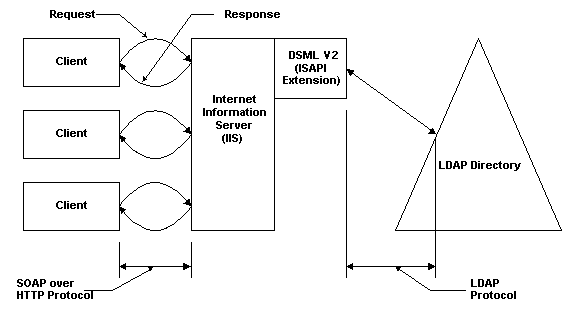| Directory Services |
The SOAP Request and Response binding method uses SOAP to bind to a server. SOAP is a lightweight protocol for data exchange in a distributed environment and consists of:
SOAP therefore defines the XML format for messages. For example, if you have a well-formed XML fragment consisting of a DSML V2 document enclosed in a pair of SOAP elements, you have a SOAP message.
This implementation of SOAP request/response binding uses HTTP 1.1 and HTTPS 1.1 as a transport for DSML V2 requests and responses. The version of SOAP used for this binding is SOAP 1.1.
The following illustration shows the data flow for a DSML V2 request and response.

In the preceding illustration, a client makes a request using the SOAP (XML) over HTTP protocol. That request goes to a server running IIS, where it is routed to a DMSL V2 ISAPI extension. There, it is converted to LDAP commands, which are sent on to the directory services. The response occurs in a reverse fashion, with the response returning to the client via the SOAP over HTTP response.
Every SOAP request and response must have an envelope element that contains a body element, and a body element that contains the DSML V2 payload. The following code example shows the general form of a SOAP message.
<Envelope> <Header> All SOAP header elements go here </Header> <Body> The DMSL 2.0 payload (document) goes here </Body> </Envelope>
The <Envelope> and <Body> elements are required, but the <Header> element is optional. For more information about the SOAP specification, see http://www.w3.org/TR/SOAP and Using DSML Services for Windows.
The following code example shows a request/response message sequence.
ccc<!-- **** DSMLv2 Request ****** --> <se:Envelope xmlns:se="http://schemas.xmlsoap.org/soap/envelope/"> <se:Body xmlns:dsml="urn:oasis:names:tc:DSML:2:0:core"> <batchRequest> <modifyRequest> … </modifyRequest> <addRequest> … </addRequest> … </batchRequest> </se:Body> </se:Envelope> <!-- **** DSMLv2 Response ****** --> <soap:Envelope xmlns:soap="http://schemas.xmlsoap.org/soap/envelope/" xmlns:xsi="http://www.w3.org/2001/XMLSchema-instance" xmlns:xsd="http://www.w3.org/2001/XMLSchema" xmlns:soapenc="http://schemas.xmlsoap.org/soap/encoding/"> <soap:Body> <batchResponse xmlns="urn:oasis:names:tc:DSML:2:0:core" xmlns:xsd="http://www.w3.org/2001/XMLSchema" xmlns:xsi="http://www.w3.org/2001/XMLSchema-instance"> <modifyResponse> … </modifyResponse> <addResponse> … </addResponse> … </batchResponse> </soap:Body> </soap:Envelope>
In the preceding example, be aware of the following: